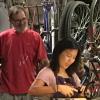Stuck at a Light on Your Bike? Here's How to Get It to Change
Greensplainer

Photo Credit: Jason Perry
Spherical cameras like these are supposed to detect vehicles at an intersection and change the traffic signal from red to green.
The “scofflaw cyclist” trope gets rolled out in the comments section of just about any article related to people riding bikes in town, usually by those who don’t believe that people on bikes belong in traffic. (Tip: We are traffic.)
Of course, some riders break the law, just like some motorists and pedestrians do. Many others don’t, which is why it was frustrating to those of us who regularly get around on two wheels that Gov. Nathan Deal vetoed Senate Bill 76, the “dead red” bill. It would have allowed people on bicycles, scooters or motorcycles to carefully advance through a red light if the intersection's vehicle detector doesn't detect them.
Whether another dead-red bill passes someday or not, here’s what you need to know to get through that intersection on your bike without being a scofflaw.
Not all intersections or lanes have vehicle detectors; some only have them in the left-turn lanes, while the rest of the lanes may be on a timed pattern. Some intersections only have vehicle detectors on minor streets where they meet busy corridors, so primary traffic is only interrupted when someone needs to turn or cross. To know if an intersection has a vehicle detector, keep an eye out for inductive loops and video detectors.
The most common vehicle detection system is an inductive loop embedded in the road. Many people mistake the tell-tale rectangles inscribed in the asphalt to be pressure pads, and think that smaller vehicles aren’t heavy enough to trigger them. They’re actually just loops of wire with a weak electric current running through them to create an electric field. When a metal object (e.g. a car) disrupts the electric field, it tells the traffic-control computer that a vehicle is there.
The problem for two-wheelers isn’t so much their weight, but how much conductive material they’re made of. Steel and aluminum work well if there’s enough of it, but carbon fiber is pretty much out of luck. Loops that are adjusted to prevent false positives can be too insensitive to “see” a bike regardless of its material.
Your best chance of detection is to place your bike on the edge of the rectangle, wheels directly on the wire. If it’s a double loop, the sweet spot is on the wire that runs up the middle. Many downtown Athens intersections have mini square-shaped loops right at the stop line for small vehicles. If proper positioning doesn’t work, lay your bike down to get more metal into the electric field. This isn’t practical for everyone, and it’s not an everyday solution, but it’s a useful trick in a pinch.
Video detectors are a relatively new development. The next time you’re at an intersection, look up on the poles nearby—if you see webcam-like spheres or oblong security-like cameras, they are video vehicle detectors. (There are some intersections where they’ve been installed to replace inductive loops. Five Points is a good example.) They are focused on the area directly behind the thick, white stop line, and they detect sudden changes in the video image and use an algorithm to determine if what they see is a vehicle. The best place to be on your bike is the center of the lane, just behind that line, though some will see you in the bike lane. (Sanford at Baldwin is an example.) Pretend the intersection is a wild animal and make yourself big. You may need to turn your bike to make it appear wider.
Video detectors can miss bikes at night, especially at dark intersections. If your headlight (you have a headlight, right?) isn’t bright enough to light up the road in front of you, try lifting your front end so that the light points directly at the camera. You can also shine a small flashlight or your phone’s flash LED at it. This works like a charm crossing Baxter Street on Newton.
If these techniques don’t work, you must choose to wait for a car to get behind you or dismount and use the crosswalk. If you encounter a problematic vehicle detector, contact Athens-Clarke County Traffic Engineering, or if it is on the University of Georgia campus, then email [email protected].
A special note for car drivers: Please don’t hang so far behind cyclists at traffic lights that your car doesn’t reach the sensor. I know you’re trying to be courteous, but it’s actually not helpful.
Keywords
More by Jason Perry
-

-

BikeAthens Expands Bike Recycling Program in New Space
Greensplainer
-

A Glaring Problem With Athens' New Streetlights
Greensplainer









comments